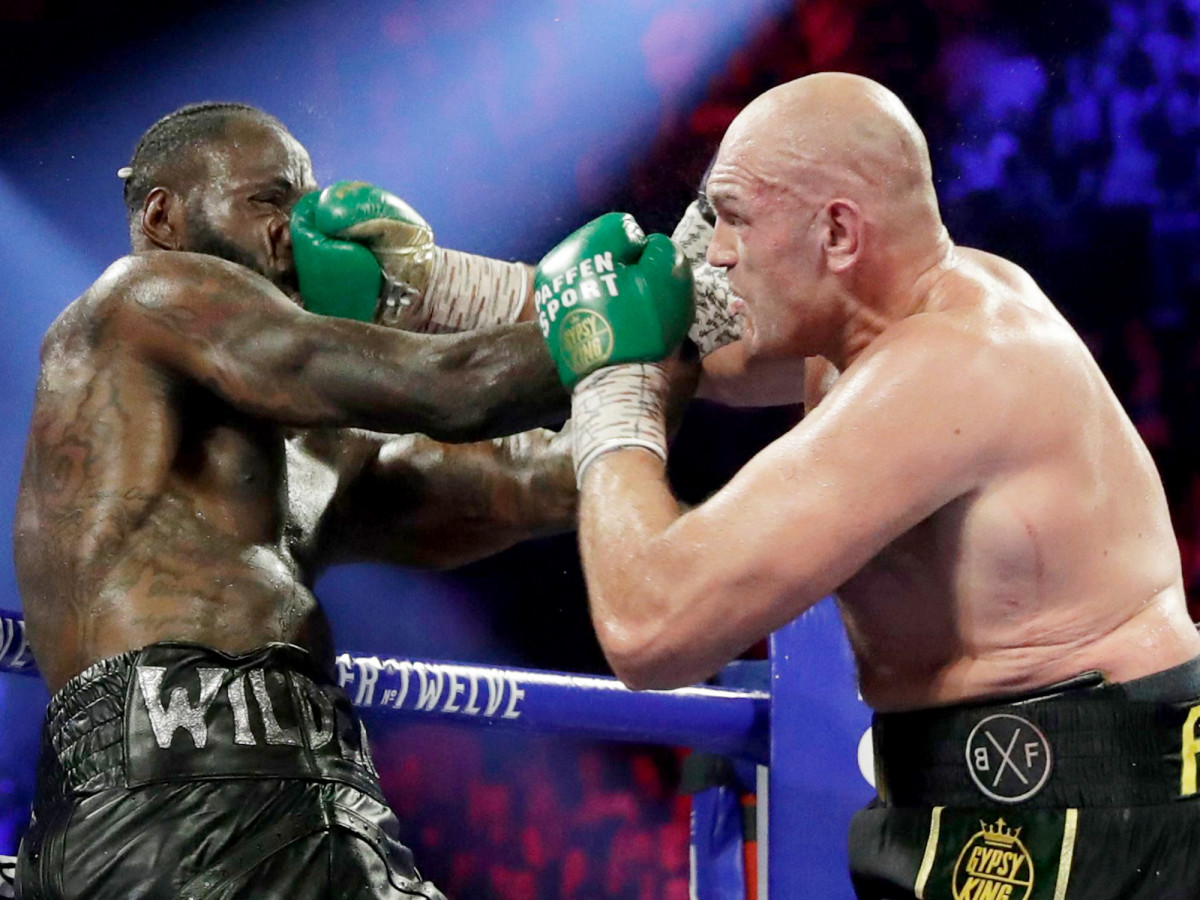'The King Has Returned': The Second Coronation of Tyson Fury

LAS VEGAS — There came Tyson Fury, round after round, second after second, doing to Deontay Wilder what Deontay Wilder usually does to everybody else. Meaning: absolutely overpowering him, sending him to the canvas, landing powerful right hand after powerful right hand. This was some Saturday night, inside the Grand Garden Arena, in front of Patrick Mahomes and Leonardo DiCaprio and Lance Armstrong. This was for the Brits who never sat down and for the Brit who never backed down, for the oddsmakers who favored Wilder and the pundits who predicted he would win by knockout.
This was Tyson Fury’s second coronation, a victory more significant—and more entertaining—than when he topped Wladimir Klitschko by unanimous decision in 2015. Fury rode into the arena on a throne, wearing a plush red robe, being carried by four men while lip syncing to Patsy Cline. Then he went out and claimed one of the most important crowns in sports, resuming his reign as heavyweight champion. Where the first match between the men had ended in a draw in December 2018, with both boxers claiming legitimately that they had won, this time, Fury left no doubt.

“The king has returned,” Fury said right afterward, as the still-standing, still-full crowd drowned him out with applause. Then he took the microphone and serenaded the crowd.
The evening felt like boxing used to feel, back when it dominated the sports landscape, when the heavyweight champion of the world was the baddest man in sports and the world stopped to listen to or watch big fights. There were celebrities and strobe lights, singers and actresses, smoke and song and an unmistakable vibe. There were heavyweight legends Mike Tyson, Evander Holyfield and Lennox Lewis climbing between the ropes before the ring walks, as if to signify the continued resurgence of boxing’s most storied division.
Those ring walks, by the way, must rank among the most elaborate—and absurd—in boxing history. Fury’s was actually a ring ride. He blew kisses to the crowd. He spread his arms wide. He wore an actual crown. Wilder came in next, clad in all black, except when his mask lit up red. He had a performer with him, rapping about his life.
And while all of that was insane, like the opening to a music video rather than a fight, the night then took an even crazier turn. Let’s start with this: in his professional career, Wilder had fought 43 times before Saturday. He ended 41 of those fights by knockouts, winning another by decision and earning a draw against Fury in their first meeting, while still showcasing his power in knocking Fury down and almost out. Exactly no one expected Fury to be the fighter who came out hammering. But hammer away he did.
Fury struck Wilder with right hands and left hands, with jabs and hooks and combinations. In the first round, he landed several hard rights that brought the crowd to its feet—those that had sat down, anyway.
The fight didn’t continue on this way. It got worse. Fury not only made Wilder bleed, but he licked some of the blood off Wilder's neck. He appeared to deploy a new strategy in the rematch, too. He went after Wilder, forcing the action, sure, but also closing the space between them, making it harder for Wilder to land a big right hand. In between flurries, Fury leaned on Wilder and wrestled with him, thereby weakening his more powerful opponent. He also concentrated on delivering body shots that landed with heavy thuds. Think Rocky in the meat locker, except in real life. All of that, when taken together, slowed Wilder down. He started to look wobbly early on, like by the second round.

In the third, Fury staggered Wilder, forcing him off balance. Wilder grasped at Fury in desperation, holding on for his fight night life. Then Fury hit him with a quick left and came over that jab with a stinging right that sent Wilder wobbling to the canvas. On the replay, the right looked like it might have hit Wilder behind his left ear. Regardless, it seemed to mess with his equilibrium. He never looked steady again.
The fight was never close. Not for one second. Fury knocked Wilder down again in the fifth round and almost toppled him down several other times, but those were ruled slips. When Wilder landed on his backside in the fifth, fans sitting 20 rows from the ring could hear the thud sound his body made when it hit the canvas. Fury continued to lean, continued to land body shots, continued to push forward. The shock of Fury dominating so widely started to dissipate and the question became not whether he could knock Wilder out but when he would.
The referee called the bout in the seventh and the crowd roared so loud the ground at Grand Garden Arena seemed to shake. In the immediate aftermath, Wilder said he would not make excuses, that he had lost and to the better man. Fury said Wilder would again win a championship someday. Not Saturday. Not the way that fight went down. “Even the greatest have lost and come back,” he said.
In some ways, Fury’s victory adds intrigue to an already-interesting division that hasn’t been this compelling since Lewis, Tyson and Holyfield were knocking each other down. A trilogy with Wilder seems imminent, if Wilder wants it. A Fury match with Anthony Joshua would rank among the biggest bouts ever in the United Kingdom. They’d sell out Wembley Stadium. The world would stop to watch, just like it used to. And just like when Tyson Fury knocked out one of boxing’s most prolific knockout artists late Saturday, the night the heavyweight division again crowned its latest ruler. “The king has returned to the top of the throne!” Fury screamed again.
